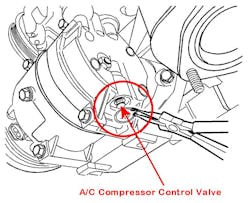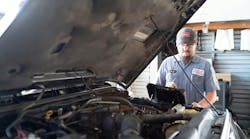Vehicle: 2009 Chevrolet Aveo, L4-1.6L
Mileage: 98,266
Problem: The vehicle was brought to the shop because the A/C was not working.
Details: The technician connected a scan tool and found no diagnostic trouble codes. Next, he checked to be sure all the related fuses had battery (B+) voltage. They did. After that, the technician verified that the vehicle had a manual HVAC system with a V5 compressor, then connected his A/C gages. The refrigerant level was low, and the A/C compressor clutch would not engage.
He charged the A/C system with 1.1 lbs of refrigerant. The low-side and high-side refrigerant pressures at idle were: 75/140 PSI. At 2500 RPM, they were: 80/140 PSI. The A/C lines were warm, and the radiator cooling fan was not running. He replaced the A/C pressure sensor, but it did not help. At this point, he called ALLDATA Tech-Assist.
The Tech-Assist consultant advised to first verify that the evaporator temperature sensor, engine coolant sensor, and high-pressure sensor readings were within specifications. He added that, if the technician found no problems, he should check the A/C compressor control valve in the back of the compressor for debris and make sure that the valve could move freely.
Confirmed Repair: After verifying that all three sensor values were within specifications, the tech inspected the A/C compressor control valve at the back of the compressor. It was stuck. He replaced the control valve and the air conditioner blew cold air again.
Bonus Tech-Assist A/C Tip:
How to test for large A/C leaks when the charging station refuses to charge
Say a vehicle is brought in with no refrigerant in the A/C system or you have completely evacuated the system. If the recovery/charging station determines that there is a “large leak”, it may not allow you to recharge the system. How do you find the leak under those conditions?
Use a nitrogen leak test kit to find the leak. You can fill the system with nitrogen as per the kit’s instructions and listen for any hissing sounds, and/or use the supplied solution to create bubbles at the leak site.
Information provided by ALLDATA


